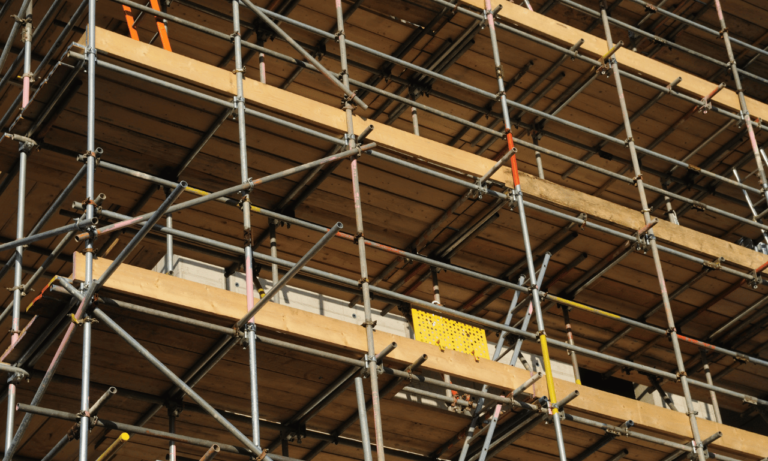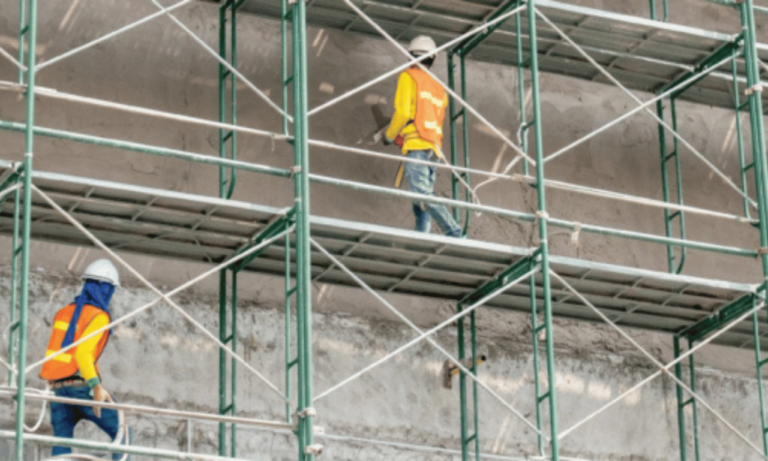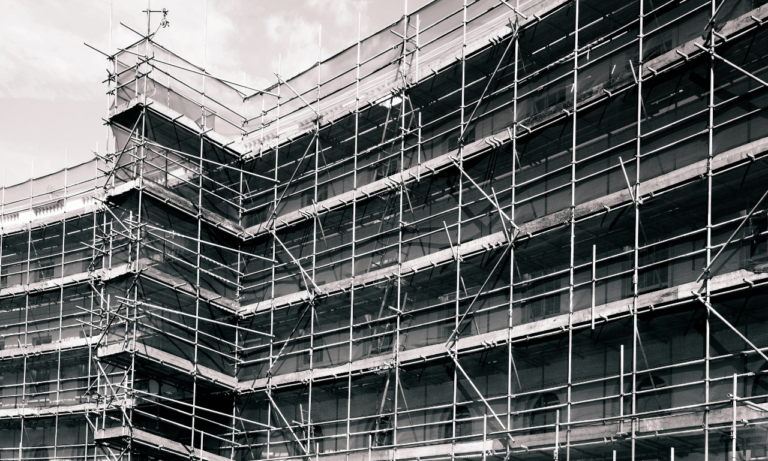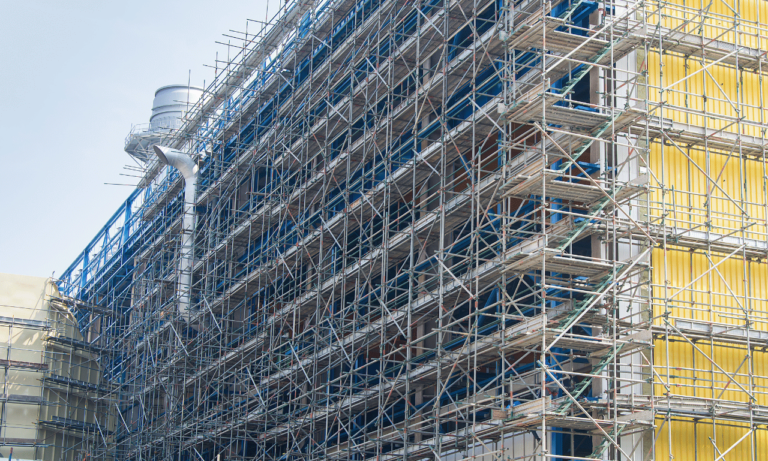Phone:
(+65)8319-0742
When it comes to professional painting projects, the right equipment can make all the difference. One essential tool that every professional painter should have in their arsenal is scaffolding. Painters’ scaffolding provides stability and reach, offering a safer and more efficient alternative to ladders or other platforms. Whether you’re working on building exteriors or interior projects, having the right scaffolding can greatly enhance your painting abilities.
Many painters choose to hire scaffolding rather than own it because it requires expert design, assembly, and maintenance. This way, you can focus on your craft while leaving the scaffolding logistics to the professionals. One popular choice for painters is aluminium scaffolding, known for its lightweight and portability. It allows you to easily move the scaffolding around the site, both internally and externally, giving you more flexibility in your painting process.
So, what are the advantages of using scaffolding for painting projects? First, it offers better stability compared to ladders, providing a secure platform for you to work on. Additionally, scaffolding offers more room to work, allowing you to cover wide areas by easily walking across the platform. This means you can achieve better coverage in less time, boosting your overall efficiency as a professional painter.
Key Takeaways:
- Painters’ scaffolding is essential for professional painters working at height.
- Aluminium scaffolding is a popular choice due to its lightweight and portability.
- Scaffolding offers better stability, more room to work, and increased efficiency.
- There are different types of scaffolding platforms available for painters.
- Choosing the right scaffolding requires considering factors like safety, ease of use, suitability for the worksite, and cost.
Why Do Painters Need Scaffolding?
When it comes to painting building exteriors or working on new construction projects, painters can greatly benefit from using scaffolding. Unlike ladders or other platforms, scaffolding provides stability and a convenient horizontal platform that allows painters to cover wide areas of walls with ease. Let’s explore why painters rely on scaffolding for their painting projects.
First and foremost, safety is a paramount concern for painters. Scaffolding offers a secure and sturdy work surface, minimizing the risk of accidents and falls while working at height. With scaffolding, painters can confidently move around and focus on their painting tasks, without worrying about potentially dangerous situations.
Efficiency is another key advantage of using scaffolding. Unlike ladders that may need frequent repositioning, scaffolding provides a larger and more stable platform that allows painters to access a wider area without constant adjustments. This saves time and effort, enabling painters to complete their projects more efficiently.
Professional painters often choose to hire scaffolding rather than own it themselves. This is because scaffolding requires expert design and assembly, which may be beyond the skills and resources of individual painters. By hiring scaffolding, painters can ensure that they work with professionally designed equipment that meets safety standards and regulations.
Additionally, hiring scaffolding saves painters time and effort on construction and maintenance. Instead of worrying about the setup and upkeep of scaffolding, painters can focus on their core painting tasks. Some painters even rely on scaffold companies to provide and set up the scaffolding for their independent projects, further streamlining the process.
To illustrate the importance of scaffolding for painters, consider the following examples:
| Situation | Scenario |
|---|---|
| Exterior House Painting | A professional painting crew is hired to paint a three-story house. They utilize scaffolding to reach the high areas of the house’s exterior efficiently and safely. |
| Commercial Building Renovation | A team of painters is tasked with repainting the interior of a large office building. They set up scaffold towers at various locations throughout the building, enabling simultaneous work on multiple floors. |
| New Construction Project | A group of painters is involved in the construction of a new residential complex. They collaborate with the construction company and utilize the scaffolding already provided at the site. |
As you can see, scaffolding plays a crucial role in providing painters with the necessary stability, safety, and platform they need to carry out their painting projects effectively. Whether it’s for residential, commercial, or construction painting, scaffolding remains an indispensable tool in the arsenal of professional painters.
Next, we’ll delve into the different types of scaffolding specifically designed for painters and explore the best options for painting houses.
What is the Best Scaffolding to Paint a House?
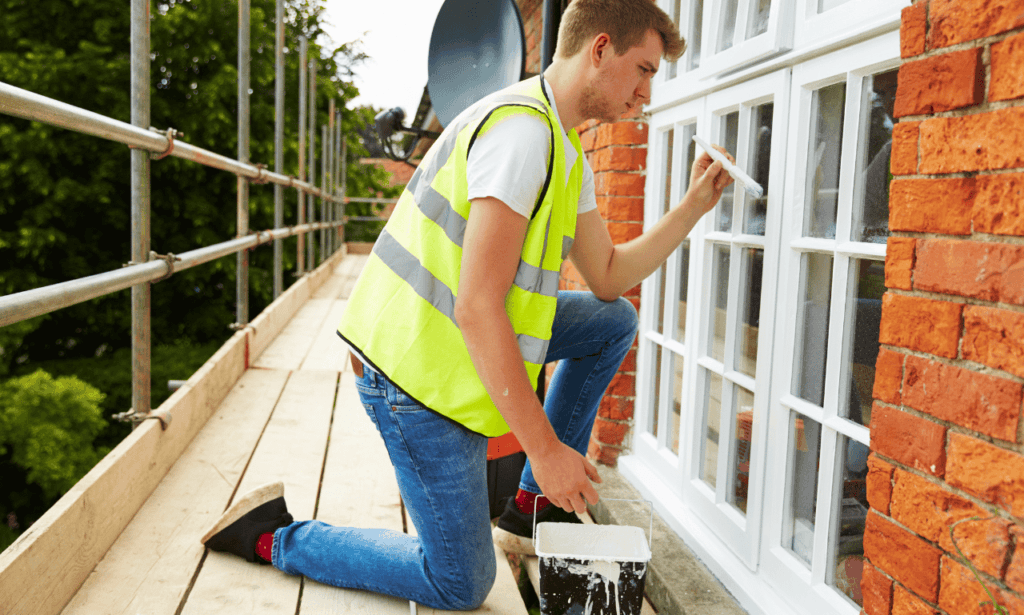
When it comes to painting a house, the right choice of scaffolding can make all the difference. Among the various options available, aluminium scaffolding stands out as the best choice for painters. Its lightweight and portable design make it an ideal solution for both internal and external painting projects.
Aluminium scaffolding offers a range of benefits that make it superior to traditional ladders or other platforms. One of the key advantages is its superior stability and safety. Unlike ladders, aluminium scaffolding can be erected with guard rails to prevent falls, providing a secure working environment for painters.
In addition to safety, aluminium scaffolding provides ample room to work and allows for horizontal freedom of movement. This means that painters can easily navigate around the house, reaching every corner with ease. The spacious platform ensures that painters have enough space to set up their equipment and supplies, improving overall efficiency and productivity.
While aluminium scaffolding is the top choice for painting a house, it’s important to note that different painting projects have varying requirements. In some cases, trestle scaffolds or A-frame scaffolding may be more suitable depending on the scope of the project.
Comparison of Different Scaffolding Types
| Scaffolding Type | Key Features |
|---|---|
| Aluminium scaffolding | Lightweight, portable, superior stability, easy to assemble |
| Trestle scaffolds | Simple planks placed over A-frame trestles, suitable for indoor use |
| A-frame scaffolding | Mobility combined with the strength of Kwikstage-type components |
Choosing the appropriate scaffolding type is crucial for achieving excellent painting results. By considering factors such as the size and nature of the painting project, painters can make an informed decision and select the scaffolding that best suits their needs.
Types of Scaffolding Platforms for Painters
Painters utilize various types of scaffolding platforms to facilitate their painting projects. These platforms provide stability, safety, and accessibility, allowing painters to work efficiently and effectively. Here are the different types of scaffolding platforms commonly used by painters:
1. Mobile Scaffolds
Mobile scaffolds, made from lightweight aluminum, are a popular choice for house painting projects. They offer portability and ease of maneuverability, allowing painters to easily move the scaffold around the work area. Mobile scaffolds for painters’ scaffolding provide a stable and secure platform to work on, ensuring the painter’s safety while painting at heights.
2. Trestle Scaffolds
Trestle scaffolds consist of simple planks or boards placed over A-frame trestles. This type of scaffolding is commonly used for indoor painting projects, providing a sturdy and reliable platform for painters to work on. Trestle scaffolds are convenient to set up and offer excellent stability for painting walls and ceilings.
3. A-Frame Scaffolding
A-frame scaffolding combines mobility with the robustness of Kwikstage-type scaffolding components. It is versatile and commonly used in various painting projects. A-frame scaffolds are easy to assemble and disassemble, making them suitable for both indoor and outdoor painting jobs. They provide a stable platform for painters to work on, allowing them to cover large areas efficiently.
4. Steel Scaffolding
Steel scaffolding is known for its strength and durability, making it ideal for larger painting projects that require heavy-duty equipment and support. It offers superior stability and safety, ensuring that painters can work comfortably even at significant heights. Steel scaffolding provides a reliable platform for painters to access hard-to-reach areas, enabling them to paint with precision and ease.
5. Suspended Scaffolding
Suspended scaffolding is commonly used for painting extremely tall buildings or structures. It involves suspending the scaffold platform by cables from the top of the building, allowing painters to work at elevated heights. Suspended scaffolding offers painters enhanced access to hard-to-reach areas, providing them with the necessary platform to complete their painting tasks effectively and safely.
| Scaffolding Type | Benefits |
|---|---|
| Mobile Scaffolds | Portability and ease of maneuverability |
| Trestle Scaffolds | Sturdy platform for indoor painting projects |
| A-Frame Scaffolding | Versatility and mobility combined with stability |
| Steel Scaffolding | Strength and durability for larger painting projects |
| Suspended Scaffolding | Access to extreme heights for tall building painting |
Choosing the right scaffolding platform for a painting project depends on various factors, including project scope, accessibility requirements, and safety considerations. By selecting the appropriate scaffolding platform, painters can optimize their work and ensure efficient and safe completion of their painting tasks.
Next, we will explore the benefits of using scaffolding for painting projects.
Benefits of Using Scaffolding for Painting

Using scaffolding for painting offers several benefits. Painters’ scaffolding provides better stability and safety compared to ladders, reducing the risk of accidents. It allows painters to cover larger areas by walking across the horizontal platform, providing increased efficiency and productivity. Scaffolding also offers more room to work, ensuring that painters have ample space to move and maneuver comfortably. Additionally, scaffolding keeps all necessary tools and equipment easily accessible on the platform, eliminating the need for frequent trips up and down. This streamlined accessibility further enhances the efficiency of the painting process.
Furthermore, scaffolding speeds up painting projects by enabling painters to work at a consistent height without the need to constantly reposition ladders. This saves time and effort, ultimately leading to more productive and timely completion of painting projects. Safety regulations and guidelines, such as those set by the Occupational Safety and Health Administration (OSHA), ensure that painters’ scaffolding is designed and used safely to prevent accidents. Adhering to these regulations provides peace of mind for both painters and clients, assuring that the work is being carried out under the highest safety standards.
Advantages of using painters' scaffolding for painting projects:
- Enhanced stability and safety
- Increased coverage of larger areas
- Ample room to work and move
- Easy accessibility to tools and equipment
- Improved efficiency and productivity
- Time-saving by eliminating the need for constant repositioning of ladders
- Compliance with safety regulations and guidelines
By utilizing painters’ scaffolding, professional painters can ensure a safer work environment, maximize productivity, and deliver high-quality results for their clients.
Tips for Choosing and Using Scaffolding for Painting
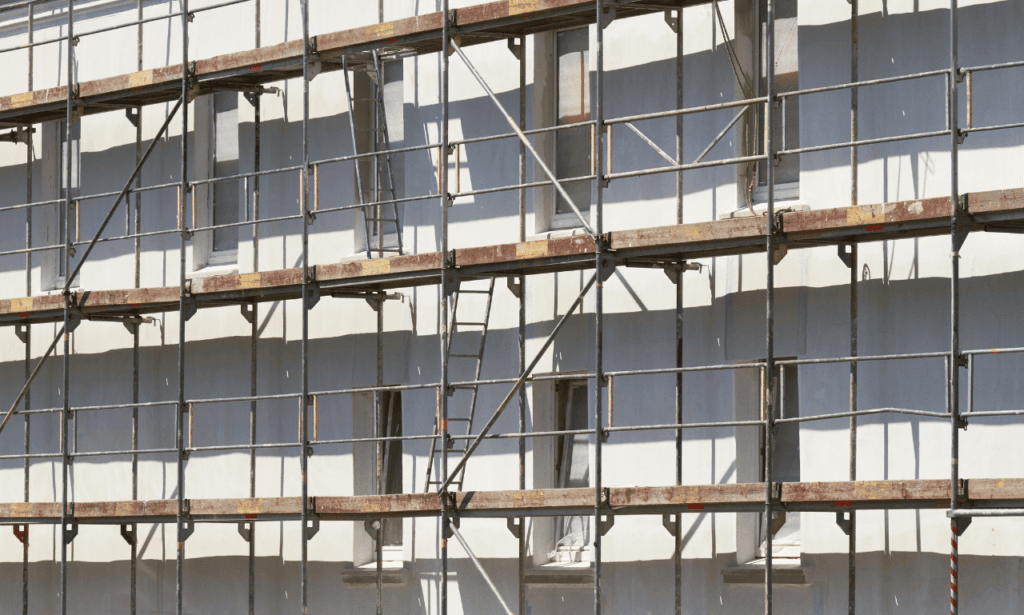
When it comes to selecting the right scaffolding for your painting projects, there are several factors to consider. Prioritizing safety, ease of installation and use, suitability for the worksite, and cost are key aspects that can guide your decision-making process. By carefully evaluating these factors, you can ensure that you choose the most appropriate painters’ scaffolding for your needs.
Safety First
- Ensure that the scaffolding you choose meets industrial and regulatory safety standards, such as OSHA requirements. Safety should always be a top priority to protect yourself and your team.
- Consider the stability of the scaffolding system. Look for features like sturdy construction, secure guardrails, and non-slip platforms to minimize the risk of accidents and falls.
Ease of Installation and Use
- Balance simplicity with practicality when selecting a scaffolding system. Opt for equipment that is easy to set up and dismantle, allowing you to save valuable time during your painting projects.
- Choose scaffolding that provides user-friendly functionalities, such as adjustable heights and locking mechanisms. This will ensure a hassle-free painting experience, even when working at different elevations.
Suitability for the Worksite
- Consider the specific requirements of your worksite when choosing scaffolding. Assess the height of the subject you will be painting, the type of work you will be doing, and the load capacity that will be required.
- Take into account the size and layout of the area you need to access, as well as any potential obstacles or restricted spaces. This will help you select scaffolding that fits seamlessly into your worksite.
Cost and Value
- Evaluate the cost effectiveness of different scaffolding options by considering their durability, lifespan, and overall value they bring to your business.
- Renting scaffolding can be a cost-effective solution for short-term projects, while purchasing may be more economical for long-term or frequent use. Consider the maximum height you anticipate needing for your painting project to make the best decision.
Instructions and Safety Tips for Scaffolding Painting
When it comes to painting projects, using painters’ scaffolding is essential to ensure safety and efficiency. Here are some important instructions and safety tips to follow when setting up and using scaffolding for painting:
1. Follow the manufacturer's instructions:
Always refer to the manufacturer’s guidelines and instructions when assembling and using the scaffolding. These instructions will provide specific details on proper setup and usage, ensuring the scaffolding is stable and secure.
2. Check for loose bolts:
Prior to using the scaffolding, inspect all the bolts and connections to make sure they are tight and secure. Loose bolts can compromise the stability of the scaffolding and pose a safety risk. Tighten any loose bolts before proceeding with the painting project.
3. Ensure a level and solid ground:
Place the scaffolding on a level and solid surface to ensure stability during the painting process. Uneven or unstable ground can cause the scaffolding to tilt or wobble, increasing the risk of accidents. Use leveling devices, such as adjustable base plates, to achieve a stable foundation.
4. Use tie-in devices or heavy wire:
When working at heights, it’s crucial to secure the scaffolding to prevent it from tipping or moving. Use tie-in devices or heavy wire to anchor the scaffolding to a secure structure or fixed point. This will provide additional stability and minimize the risk of falls.
5. Install guard rails:
Guard rails are vital for preventing falls from the scaffolding platform. Ensure that guard rails are properly installed and in good condition before starting the painting project. Guard rails should be securely attached and at an appropriate height to provide a protective barrier.
6. Carry necessary equipment and materials:
When ascending the scaffolding, always carry the necessary painting equipment and materials with you. This will minimize the need to go up and down the scaffolding repeatedly, saving time and reducing the risk of accidents.
7. Paint one section at a time:
Focus on painting one section at a time to maintain stability and balance on the scaffolding platform. Moving the scaffolding as needed will allow you to reach different areas without overextending or compromising your safety.
8. Adhere to safety rules and regulations:
It is essential to follow safety rules and regulations, such as those set by OSHA, when using scaffolding for painting. These guidelines provide comprehensive safety standards that ensure the well-being of workers. Familiarize yourself with these regulations and implement them throughout your painting project.
By following these instructions and safety tips, you can confidently and safely use scaffolding for your painting projects, ensuring both efficiency and protection for yourself and your team.
Conclusion
Painters’ scaffolding is an essential tool for professional painters working at height. With its stability, reach, and safety features, it surpasses ladders and other platforms as the preferred choice. Whether it’s painting house exteriors or working on new construction projects, scaffolding provides the stability needed to cover larger areas efficiently.
There are various types of scaffolding platforms available, including mobile scaffolds, trestle scaffolds, A-frame scaffolding, steel scaffolding, and suspended scaffolding. Each type has its own benefits and suitability for different painting projects, allowing painters to choose the most appropriate option for their needs.
When selecting and using scaffolding for painting, safety should always be the top priority. Ensuring proper installation, considering ease of use, and evaluating cost and value are crucial factors to consider. By adhering to safety guidelines and following manufacturer’s instructions, painters can utilize scaffolding effectively and securely, optimizing their painting projects and achieving superior results.
FAQ
Why is scaffolding essential for professional painters?
Scaffolding provides stability and reach, making it safer and more efficient than ladders or other platforms for working at heights. It also offers more room to work and allows painters to cover large areas by walking across the platform.
Why do painters choose to hire scaffolding instead of owning it?
Hiring scaffolding is preferred because it requires expert design, assembly, and maintenance. Many painters may not have the necessary skills for proper scaffolding setup, so it is more convenient to rent from professionals.
What is the best type of scaffolding for painting a house?
Aluminium scaffolding is the best choice for house painting due to its lightweight and portability. It is easy to assemble and move around both internally and externally. Aluminium scaffolding provides better stability and safety compared to ladders.
What are the different types of scaffolding platforms used by painters?
Painters use various types of scaffolding platforms, including mobile scaffolds, trestle scaffolds, A-frame scaffolding, steel scaffolding, and suspended scaffolding.
What are the benefits of using scaffolding for painting?
Using scaffolding offers benefits such as better stability and safety, the ability to cover larger areas, more room to work, and increased efficiency on painting projects.
What are some tips for choosing and using scaffolding for painting?
When choosing scaffolding, prioritize safety, consider ease of installation and use, ensure suitability for the worksite, and evaluate the cost. Follow manufacturer’s instructions for proper setup and use, and adhere to safety regulations and guidelines.
What are some instructions and safety tips for painting with scaffolding?
Ensure the scaffolding is properly assembled and check for any loose bolts. Place the scaffold on a level and solid ground for stability and use tie-in devices or heavy wire to secure it when working at great heights. Install guard rails, carry necessary equipment, and paint one section at a time, moving the scaffold as needed. Always follow safety rules and regulations, such as those from OSHA.


